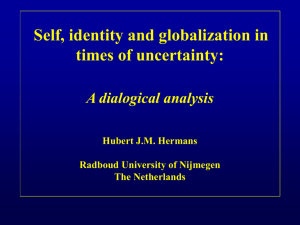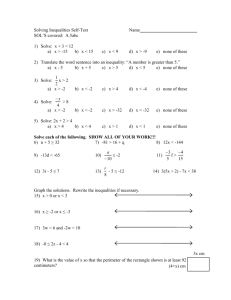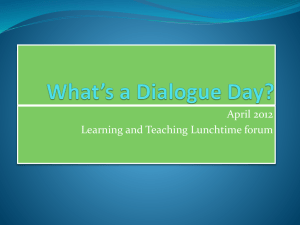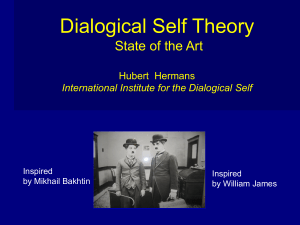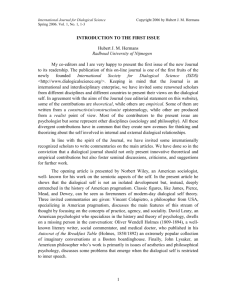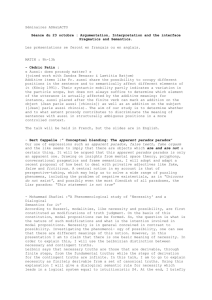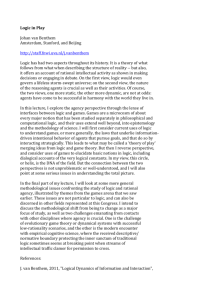Sample Title of a Sample Paper - International Journal for Dialogical
advertisement
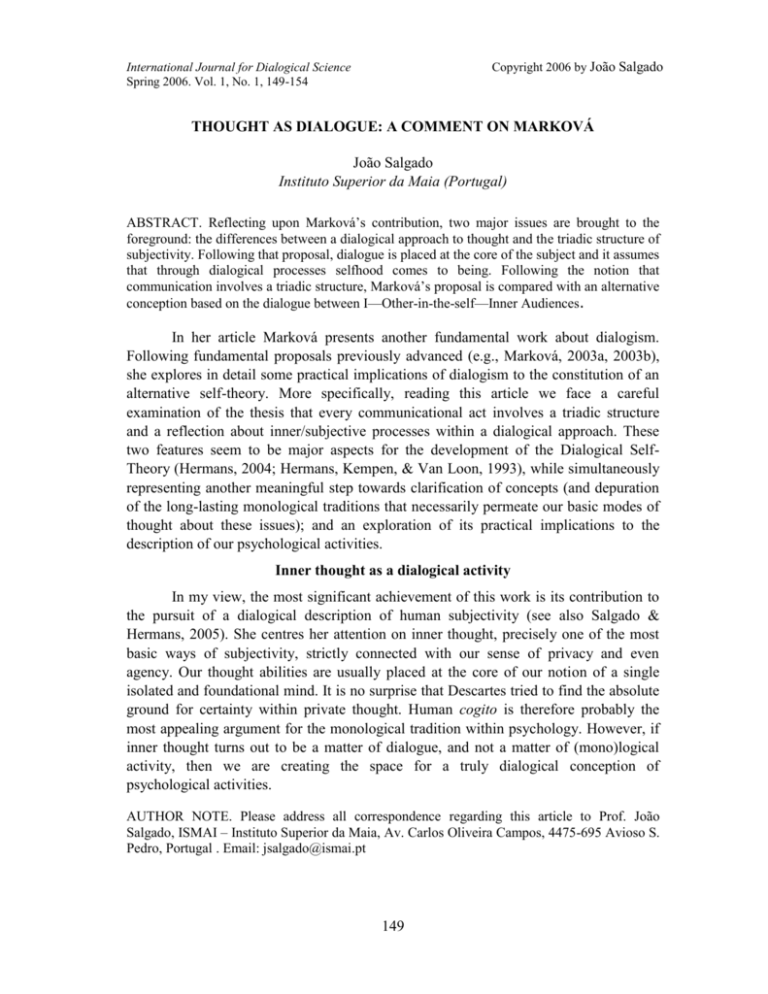
Copyright 2006 by João Salgado International Journal for Dialogical Science Spring 2006. Vol. 1, No. 1, 149-154 THOUGHT AS DIALOGUE: A COMMENT ON MARKOVÁ João Salgado Instituto Superior da Maia (Portugal) ABSTRACT. Reflecting upon Marková’s contribution, two major issues are brought to the foreground: the differences between a dialogical approach to thought and the triadic structure of subjectivity. Following that proposal, dialogue is placed at the core of the subject and it assumes that through dialogical processes selfhood comes to being. Following the notion that communication involves a triadic structure, Marková’s proposal is compared with an alternative conception based on the dialogue between I—Other-in-the-self—Inner Audiences. In her article Marková presents another fundamental work about dialogism. Following fundamental proposals previously advanced (e.g., Marková, 2003a, 2003b), she explores in detail some practical implications of dialogism to the constitution of an alternative self-theory. More specifically, reading this article we face a careful examination of the thesis that every communicational act involves a triadic structure and a reflection about inner/subjective processes within a dialogical approach. These two features seem to be major aspects for the development of the Dialogical SelfTheory (Hermans, 2004; Hermans, Kempen, & Van Loon, 1993), while simultaneously representing another meaningful step towards clarification of concepts (and depuration of the long-lasting monological traditions that necessarily permeate our basic modes of thought about these issues); and an exploration of its practical implications to the description of our psychological activities. Inner thought as a dialogical activity In my view, the most significant achievement of this work is its contribution to the pursuit of a dialogical description of human subjectivity (see also Salgado & Hermans, 2005). She centres her attention on inner thought, precisely one of the most basic ways of subjectivity, strictly connected with our sense of privacy and even agency. Our thought abilities are usually placed at the core of our notion of a single isolated and foundational mind. It is no surprise that Descartes tried to find the absolute ground for certainty within private thought. Human cogito is therefore probably the most appealing argument for the monological tradition within psychology. However, if inner thought turns out to be a matter of dialogue, and not a matter of (mono)logical activity, then we are creating the space for a truly dialogical conception of psychological activities. AUTHOR NOTE. Please address all correspondence regarding this article to Prof. João Salgado, ISMAI – Instituto Superior da Maia, Av. Carlos Oliveira Campos, 4475-695 Avioso S. Pedro, Portugal . Email: jsalgado@ismai.pt 149 SALGADO But what does the argument that “thought is dialogue” precisely mean? Does it make a difference or is it just a way of preserving coherence within a dialogical perspective, but not implying any meaningful change in the way we conceptualize thinking? In some previous works, my colleagues and I have tried to argue that it must represent a change in the way we conceptualize thought and all other psychological processes, otherwise dialogism would not be necessary or useful (see Salgado & Ferreira, 2005; Salgado, Ferreira, & Fraccascia, 2006; Salgado & Gonçalves, 2006; Salgado & Hermans, 2005). In this article, Marková gives another contribution to this theoretical and simultaneously practical problem. Showing that a dialogical conception of thought needs the simultaneous description of the relation between three bounded elements, she makes it clear that a dialogical conception is in fact different. In order to create this alternative model of thought, the fundamental feature becomes its addressivity and relational character. Therefore, more important than “what we think” the dialogical research within this domain should start to focus on “what do we do with this thought? And to whom?”. Pursuing this task would be a major achievement for a dialogically informed psychology. Why triads and not dyads? As Marková (2003b) clearly states, a dialogical account typically assumes that human beings are socially addressed existences. Taking Bakhtin (1981, 1984) as a source of inspiration, we may say that we are always in a process of addressing someone else and through this intercoordination with others meaning is brought to being. Meaning involves a dialogical activity and consequently every act is always a response. Therefore, within a dialogical account, communication is one of the keywords (Salgado & Gonçalves, 2006). Taking dialogue as the main metaphor, dialogism may seem to endorse a stance that meaning-making implies a dyadic solution, in which a person would be depicted as someone addressing other people. This kind of solution decentres the ego and simultaneously consider otherness as a main feature of selfhood. However, the dialogue structure is probably even more complex. Marková (2003b), drawing upon the work of Moscovici (1984), has argued that, in order to explain the complexities of meaning-making, a dialogical approach must consider a triadic structure and not a dyadic one. Human communication, she claims, involves a negotiation of social constituted objects (the Object or, more precisely, Social Representations of objects) between an Ego and an Alter. Thus, Ego-AlterObject is the basic structure of human communication and intercoordination by which meaning is brought to being. In this article, she returns to this same formulation. 150 THOUGHT AS DIALOGUE As Marková (2003b) convincingly argues, and drawing upon Moscovici’s work (1984) we may say that between Ego and Alter (that stands for another person, a group, a community and so on) are always negotiating an Object (social representation). Thus, within her perspective a dialogical approach always implies a triadic relation between Ego-Alter-Object. In this text she goes one step further and starts an exploration of subjective processes based on that formulation, while simultaneously referring to some previous works in which I have been involved. Due to her mention of those efforts, and in order to develop a more detailed commentary, I will briefly present those ideas. Working on triads within subjectivity Inspired by this proposal, as well as by other authors that call our attention to the triadic structure of communication (e.g., Jacques, 1991; Linell, in preparation), some colleagues and I have tried to contribute to this discussion, through our reflections about this issue (see Salgado & Ferreira, 2005; Salgado, Ferreira, & Fraccascia, 2006 Salgado & Gonçalves, 2006; Salgado & Hermans, 2005). This reflection has been somehow based on the following image: if Ego and Alter share a certain social representation, what differentiates these two elements? Taking an example left by Volŏsinov (1976) as inspiration, imagine someone that, while walking in a park with a friend, says “It’s cold” and the friend answers“It’s cold”. They share the same representation of the situation, but this dialogue may be rich in subtleties not easily grasped by an observer that does not know this relationship and the specific history of each of the rejoinders. The main point is that while saying this to each other, there is necessarily a third party involved – and this third party is not necessarily the same for each of the interlocutors. For example, one of them may have said “It’s cold” because he was thinking about his family and the other may answer the same because “It’s cold” works as an echo of his feelings about a particular person he was talking about. In this case, they are negotiating the situation with words and representations – and not negotiating words or representations – and, in order to better understand them we need to consider those specific third parties implicitly evoked, while maintaining contact with the second party (the other). Based on these somehow private and frequently hidden audiences of our acts, we have proposed a triadic model of a dialogical self (Salgado & Ferreira, 2005; Salgado, Ferreira, & Fraccascia, 2006) at each given moment, each I-position is addressing an Other-in-self (the present or virtual other that we are trying to address); nevertheless, there is also a third party involved, in the form of “Inner Audiences” that shape the specific relation between the Ego and the Other-in-self. Our main goal has been to contribute to the constitution of a dialogical account of subjective processes, while not forgetting the necessary interplay with “real” others. The third party does not need to be hidden in our formulation; in fact, if two people are discussing a third person, they probably share (but only partially) the third party. It is portrayed as part of the 151 SALGADO personal history that is explicitly or implicitly evoked. Simultaneously, it is always a “third” element or, if you want, a third communicational agency and not only a representation (even if it can be evoked by representational means). Therefore, as she states in this article, I completely endorse Marková’s position that we need three elements to describe dialogical dynamics: Ego-Alter-Third. However, there are differences between her proposal and the ones I have been involved with. The most obvious one is the substitution of the term “Other-in-the-self” by “Inner Alter”. Her terminology is probably more appealing than ours and I fully endorse that substitution. However, her description of the Inner Alter is closer to our notion of “Inner Audiences” than to the notion of “Other-in-self”. And there is a valid reason for that: while we have proposed a simultaneous triadic relation between I—Other-in-self— Inner Audiences, she proposes a distinction between external dialogues and internal ones. In the external dialogues, the person is actively involved, as an Ego, with an Alter in a negotiation of an Object, while in internal dialogues we have the Ego negotiating with an Inner Alter. In this sense, Marková is giving us a significant contribution to the field, focusing our attention towards internal and external dynamics (both dialogically-based) that feed each other. In our common existence we easily find situations in which inner dialogues prevail over external dialogues (e.g., in small pauses in a dialogue) and viceversa. This adds a more dynamic character to my previous efforts on this domain. However, there is a question left: Is this Inner Alter a second party – a You – or a third party – a She/He/It/They? In my point of view, it is more adequately described as a second party and her description better fits the notion of “Other-in-the-self” than that of “Inner Audiences”. My point is that when a person is internally addressing someone (inclusively, addressing oneself) this addressed one works as the more obvious partner of the dialogue, but there are also third ones involved. Taking an example from Marková, when Ivanov (Ego) addresses himself (Other-in-the-self or Inner Alter) not accepting the relationship between Ivanov and his children, these latter are part of the third party. Concluding remarks Therefore, beyond these differences I see remarkable similarities between our proposals. We are both agreeing that communication involves a triadic relationship and that even inner dialogues are examples of that same triad. In the end, the most striking difference seems to be the difference that Marková establishes between internal and external dialogues. She claims that external dialogues follow the structure Ego-AlterObject (Social representation) and internal ones follow the structure Ego-Inner AlterObject. My own point of view is somewhat different. I argue that external dialogues are more complex than internal ones. Stating my position more clearly: in these situations, the person is, in fact, usually more involved in external dynamics and coordination with 152 THOUGHT AS DIALOGUE a “real” other – and therefore the Ego-Alter-Object dynamic is usually prevalent over internal ones. However, the person maintains an “internal third party” co-relative of the object being negotiated between the rejoinders in the dialogue. Thus, we will have two possible and complementary modes of analysing a dialogue within this perspective: one from the point of view of an observer that depicts the external dynamics (Ego-OtherObject); and a more internal perspective, co-relative of the first (Ego-Inner Alter-Inner Audiences). In the end, Marková is showing us that a dialogical perspective implies innovations within psychology. Placing dialogue at the core of the subject, results in a decentred perspective about human psyche. Dialogue enables human life, in a corelative and coexistent tension between I and You, here and there, now and then. It is within this constant dialogue that the subject comes to being, in a constant movement of position and repositioning towards others and towards oneself and by which our life story is constantly reshaped. References Bakhtin, M. M. (1981). The dialogic imagination: Four essays by M. M. Bakhtin (C. Emerson & M. Holquist, Trans.). Austin, TX: University of Texas Press. Bakhtin, M. M. (1984). Problems of Dostoevky’s poetics (C. Emerson, Trans.). Minneapolis, MN: University of Minnesota Press. (original work published in 1929, revised in 1963) Hermans, H. J. M. (2004). The dialogical self: Between exchange and power. In H. J. M. Hermans & G. Dimaggio (Eds.), The dialogical self in psychotherapy (pp. 13-28). Hove, East Sussex: Brunner-Routledge. Hermans, H. J. M., Kempen, H., & Van Loon, R. (1992). The dialogical self: Beyond individualism and rationalism. American Psychologist, 47, 23 – 33. Jacques, F. (1991). Difference and subjectivity: Dialogue and personal identity (Andrew Rothwell, Trans.). New Haven, CT: Yale University Press. (original work published in 1982) Linell, P. (in preparation). Essentials of dialogism: Aspects and elements of a dialogical approach to language, communication and cognition. Unpublished manuscript. Marková, I. (2003a). Constitution of the self: Intersubjectivity and dialogicality. Culture & Psychology, 9, 249-259. Marková, I. (2003b). Dialogicality and social representations. Cambridge, UK: Cambridge University Press. 153 SALGADO Moscovici, S. (1984). Introduction: Le domaine de la psychologie sociale [Introduction: The domain of social psychology]. In S. Moscovici (Ed.), Psychologie sociale (pp. 5-22). Paris: Presses Universitaires de Frances. Salgado, J., & Ferreira, T. (2005). Dialogical relationships as triads: Implications for the dialogical self theory. In P. K. Oles & H. J. M. Hermans (Eds.), The dialogical self: Theory and research. Lublin, Poland: Wydawnictwo KUL. Salgado, J., Ferreira, T. & Fraccascia, F. (2006). Struttura diadica del Sè: Il ruolo dell’audience. Ricerche di Psicologia (Italy). Salgado, J. & Gonçalves, M. (2006). The dialogical self: Social, personal, and (un)conscious. In A. Rosa & J. Valsiner (Eds.), The Cambridge handbook of social cultural psychology. Cambridge: Cambridge University Press. Salgado, J., & Hermans, H. J. M. (2005). The return of subjectivity: From a multiplicity of selves to the dialogical self. Electronic Journal of Applied Psychology, 1, 313. Volŏsinov, V.N. (1976). Discourse in life and discourse in art. Concerning sociological poetics. In Freudianism. A Marxist critique. New York: Academic Press. 154
